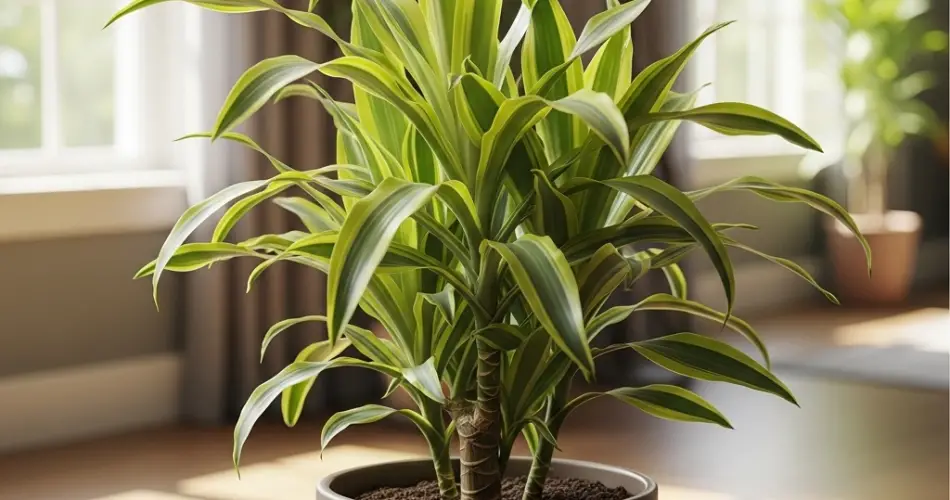Dracaena plants are among the most popular indoor choices for modern homes and apartments due to their low-maintenance nature and striking tree-like appearance. With their upright stems and long, sword-shaped leaves, Dracaenas lend a tropical, architectural feel to interiors. What makes them especially appealing is their adaptability—they thrive in pots, tolerate a range of lighting conditions, and don’t demand frequent watering.
If you’re looking to introduce greenery into your space without the stress of high-maintenance care, potted Dracaenas are an ideal choice. This guide covers everything you need to know to grow a healthy, elegant Dracaena indoors.
1. Choosing the Right Dracaena Variety for Pots
There are several Dracaena varieties suitable for indoor containers, each with unique foliage and growth patterns. Some of the most popular include:
-
Dracaena fragrans (Corn Plant): Broad, glossy green leaves and a thick cane-like stem.
-
Dracaena marginata (Dragon Tree): Thin, spiky leaves edged in red or purple.
-
Dracaena reflexa (Song of India): Variegated yellow and green foliage with a bushy growth habit.
For container gardening, choose compact or slow-growing varieties if space is limited. Tall species like D. fragrans and D. marginata make excellent focal points in corners or by windows.
2. Selecting the Ideal Pot
Dracaenas have shallow root systems, so they don’t require deep containers. However, the pot must provide adequate space for root growth and remain stable as the plant gains height.
Container considerations:
-
Size: Start with a pot 2 inches larger in diameter than the plant’s root ball.
-
Material: Terracotta or ceramic pots add weight for stability and help regulate moisture. Plastic pots are fine but may need a heavier base.
-
Drainage: Drainage holes are essential to prevent root rot. If using decorative pots without holes, keep the plant in a nursery pot and remove it for watering.
As the plant grows, repot every 2–3 years to refresh the soil and provide more space.
3. The Best Soil Mix for Dracaena
Dracaenas prefer well-draining soil that holds some moisture without becoming soggy.
Ideal soil blend:
-
One part potting soil
-
One part perlite or pumice
-
One part coconut coir or peat moss
This mix encourages proper airflow to the roots while holding just enough water between watering sessions. Avoid heavy soils that compact easily, as they can suffocate roots.
4. Light Requirements Indoors
One of the best features of Dracaena is its ability to adapt to a wide range of lighting conditions.
-
Bright, indirect light encourages faster growth and richer leaf color.
-
Moderate to low light is tolerated, especially by D. fragrans and D. marginata, though growth may slow.
Avoid prolonged direct sunlight, which can scorch the leaves, especially in hot climates. Rotate your plant occasionally to promote even growth on all sides.
5. Watering Guidelines
Dracaena plants are sensitive to overwatering, so less is more when it comes to moisture.
Watering tips:
-
Water when the top 1–2 inches of soil feel dry.
-
Use room-temperature, non-fluoridated water—Dracaena is sensitive to fluoride and salts.
-
Ensure excess water drains out completely.
Reduce watering frequency in cooler months when growth slows. Overwatering often causes yellowing leaves and mushy stems.
6. Fertilizing for Healthy Growth
Dracaena doesn’t need frequent feeding, but occasional fertilization helps maintain its lush appearance.
-
Use a balanced liquid fertilizer (e.g., 10-10-10 or 20-20-20) diluted to half strength.
-
Feed once a month during the growing season (spring and summer).
-
Skip fertilizing in fall and winter when the plant’s growth naturally slows.
Avoid over-fertilizing, as it can cause brown leaf tips.
7. Pruning and Maintenance
Regular pruning helps keep Dracaena looking neat and can also encourage branching.
Simple maintenance tips:
-
Trim any yellow or brown leaves near the base.
-
Cut back leggy stems just above a leaf node to stimulate bushier growth.
-
Wipe leaves occasionally with a damp cloth to remove dust and allow better photosynthesis.
You can propagate cut stems by rooting them in water or soil, making Dracaena easy to multiply.
8. Common Issues and How to Avoid Them
Dracaena is resilient, but a few common problems can occur:
-
Brown leaf tips: Often due to fluoride in tap water or low humidity.
-
Drooping leaves: Typically a sign of overwatering or poor drainage.
-
Leaf loss: May occur with sudden temperature changes or insufficient light.
To keep your plant healthy, provide consistent care and adjust your routine as needed with the seasons.
Conclusion
Growing Dracaena in pots is a great way to bring the beauty of a low-maintenance indoor tree into your home. With the right container, well-draining soil, and moderate care, your Dracaena will thrive for years as a tall, sculptural accent in any room. Whether you’re a beginner or a seasoned plant lover, this adaptable and forgiving houseplant is an excellent choice for modern indoor gardening.



